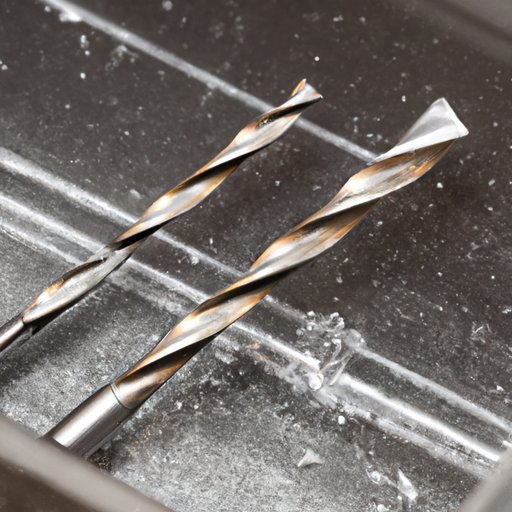
Introduction
Drilling a hole in glass may seem like a daunting task but with the right tools and techniques, it can be a simple and rewarding DIY project. Whether you are making a custom piece of art or need to repair a broken item, knowing how to drill a hole in glass is a useful skill to have. In this article, we will provide a step-by-step guide, answer frequently asked questions, compare different methods and tools, offer best practices and tips, and share a case study of someone who successfully drilled a hole in glass.
Step-by-Step Guide
The tools required for drilling a hole in glass include a drill, diamond-tipped drill bit, masking tape, a lubricant such as water or oil, and safety equipment such as gloves and eye protection. To start drilling, follow these steps:
- Select the spot where you want to drill the hole and mark it with masking tape. This will prevent the drill bit from slipping and will also help keep the glass from cracking.
- Put on safety equipment such as gloves and eye protection.
- Secure the glass using a clamp or suction cup to prevent movement while drilling.
- Apply a lubricant to the area where you will be drilling. This will help keep the drill bit cool and prevent it from overheating.
- Start drilling at a slow and steady pace, applying light pressure. Do not rush the process as this can cause the glass to crack or shatter.
- Stop drilling periodically to add more lubricant and prevent the glass from overheating.
- Once the hole is completed, remove the tape and clean the glass.
It is important to note that drilling through tempered glass should be avoided as it is designed to shatter for safety reasons.
Frequently Asked Questions
What kind of drill bit is best for drilling glass?
Diamond-tipped drill bits are the best choice for drilling glass as they are designed to grind through the hard surface. Carbide-tipped drill bits are a less expensive alternative but may not last as long.
How do I keep the glass from cracking or shattering?
Marking the spot with masking tape, using a lubricant, and drilling at a slow and steady pace are all ways to reduce the risk of cracking or shattering. It is also important to avoid drilling through tempered glass.
What safety equipment should I wear when drilling glass?
Wearing gloves and eye protection is essential when drilling glass. In addition, a dust mask can also be worn to prevent inhaling any glass particles.
Comparison Article
When it comes to drilling holes in glass, there are different methods and tools to choose from. Electric drills are faster and easier to use compared to manual drills but may be too powerful and can cause the glass to break. Diamond-tipped drill bits are more expensive but are best for drilling through harder surfaces such as glass and tile. Carbide-tipped drill bits are less expensive but are better suited for softer materials such as wood and plastic.
When deciding on which method or tool to use, consider the project requirements and your own skill level. If you are a novice, it may be best to start with a manual drill and carbide-tipped drill bit until you are more comfortable with the process.
Best Practices and Tips
Preparing the workspace and securing the glass are important steps that should not be overlooked. Make sure to have a stable work surface and secure the glass with a clamp or suction cup to prevent movement. Applying a lubricant and taking your time while drilling will also help prevent the glass from cracking or shattering.
Additional tips include drilling the hole from both sides to prevent chipping and keeping the drill bit cool by constantly adding lubricant. It also helps to start with a small pilot hole and gradually increase the size until the desired size is reached.
Case Study
Jane had an antique glass lamp that needed a new cord but the existing holes were too small to fit the new cord through. She wanted to drill a larger hole but was hesitant to do so. After researching different methods and tools online, she decided to use a manual drill and carbide-tipped drill bit to start. She marked the spot with masking tape, secured the glass with a clamp, and applied water as a lubricant. She drilled a small pilot hole first and gradually increased the size until the desired size was reached. The result was a perfectly drilled hole and a restored lamp.
Conclusion
Drilling a hole in glass may seem intimidating but with the right tools and techniques, it can be an achievable DIY project. Following safety precautions and taking your time while drilling will help reduce the risk of cracking or shattering. By mastering the skill of drilling a hole in glass, you can create custom pieces and repair broken items in a cost-effective way. We hope this article has provided you with the necessary knowledge to successfully drill a hole in glass and that you feel confident in starting your next project.





